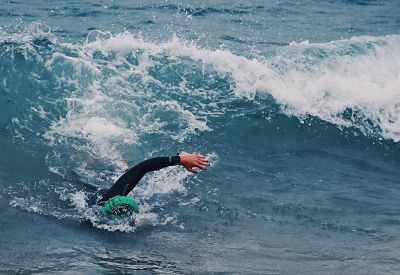Mel shares her experiences of the cold water diuresis (as you do!) and explains why you need to pee more when swimming in cold water...
I had the pleasure of taking part in 2Swim4Life, a charity event hosted at the fabulous Guildford Lido in salubrious Surrey, a few years ago. This required participants - either solo or in relay teams - to swim one mile on the hour, every hour, for 24 hours.
To anyone with a strong endurance background, swimming 24 miles with a 30-minute break (give or take) after each mile may sound like a piece of cake. In fact, many of the 400 or so people taking part were National, International and World Masters medal winners in open water, channel and indoor pool.
Aside from the physical test of swimming the equivalent of the English Channel, or 768 lengths of a 50 metre pool, the event confers a plethora of interesting challenges.
Although the pool was 'heated' and swimmers are allowed to wear wetsuits (many don't), the water temperature is around 20°C (68°F), so a little chilly if you're more used to taking a dip in your local indoor pool than the channel in your budgie smugglers...
By definition, a Lido is an outdoor pool (who knew), so swimmers are exposed to the full rigours of the English weather. It was pretty damn cold in the wee (no pun intended) small hours and at times it looked more like a Dryrobe conference. And then there's the fact that unless you are adept at micro-sleeps, or moonlight as a bat, you have to stay awake all night and endure the additional challenge of sleep deprivation.
The first rule of pee club
But there's one more unrelenting challenge that participants are generally less keen to talk about: The overwhelming need to pee. It's almost like a clandestine club. A Pee Club, in fact. And the first rule of Pee Club is that nobody talks about Pee Club.
I first joined Pee Club when, as a successful solo participant in 2Swim4Life back in 2015, I was rather alarmed by the rate at which I needed to pee. It was a rate that seemed to be completely unrelated to the amount that I was drinking. In fact, I think I probably needed to 'visit the ladies' room to powder my nose' after every single mile.
I promised those hardy souls who helped me back in 2015 that I would return the favour and act in an official 'buddy' capacity. While I was holding the towel(s), counting the lengths and force-feeding people, I couldn't help but notice the exact same behaviour that I had displayed in the swimmers I was looking after. It went something like: swim, pee, eat, possibly drink but probably not, repeat. Moreover, at least three of the four or so athletes I spoke with at any length during the event also reported experiencing cramp.
My observations as participant and buddy made me curious about the possible causes of this excessive urination, the cramping and the hydration requirements of such an event. So I've decided to break the first rule of Pee Club by talking about it here.
As with any other endurance sport, attention to good hydration practices in swimming is essential not only in order to perform well. In fact, one of the biggest threats to a swimmer's performance, safety and health is dehydration.
According to the NHS Choices website, 'Dehydration occurs when your body loses more fluid than you take in. When the normal water content of your body is reduced, it upsets the balance of minerals (salts and sugar) in your body, which affects the way it functions'.
Although there are several reasons why the normal water content of the body might be reduced, one of the most obvious causes during physical exertion, particularly in warm environments, is sweating. While dehydration is a danger during any sport, it's perhaps more of a concern during swimming for two reasons.
Firstly, when immersed in water you may not realise that you are sweating.
Secondly, because you are surrounded by water, your brain is tricked into thinking you have all the fluid you need. As a result the brain does not give off the usual 'thirst' signals and effectively removes the desire to drink.
"But wait", I hear you cry, "I thought you said it was pretty parky and surely people weren't swimming fast enough to work up a sweat?"
I'm fairly sure, or at least I hope, that the swimmers in the 'fast' lane who were banging out 21-minute miles for the whole 24 hour period did actually work up a sweat, as did the relay team who did the whole thing as an Individual Medley. But you'll be 'relieved' (groan) to learn that sweating whilst swimming is not the only reason for a reduction in the normal water content of the body and disruption of the electrolyte balance.
Cold water immersion diuresis
The other major factor that promotes loss of water and may in turn contribute to an elevated rate of sodium excretion is excessive peeing due to a phenomenon called, 'immersion diuresis'.

Diuresis is the medical term for increased urination. Immersion diuresis is the strong desire to pee after (and sometimes during!) immersion in water (especially cold water) and the explanation of this phenomenon goes something like this...
Immersion of the human body when swimming in water has several physiological effects, most of which relate to pressure and temperature. It's complicated, but bear with me.
In a standing position, the blood pressure in the legs is greater than in the upper body because of the weight of blood in the vessels above due to gravity. Gravity causes blood to pool in your legs so less blood flows back to your heart than if you were horizontal.
However, when you immerse in water the effect of gravity on your blood volume is counterbalanced by the upward thrust exerted on your body by the water, i.e. buoyancy. The blood pressure in your arms and legs becomes equalised and this equalisation increases the blood volume of the upper body (specifically the bit between your stomach and your neck - the thorax).
A similar phenomenon occurs in space where the pull of gravity is weak and, like buoyancy underwater, counteracts downward blood pressure. In space, not only can no one hear you scream, but blood does not pool in your legs. Astronauts and mission control scientists use a technical term for the upwards fluid volume shift during space flight. They call it the "Fat-Face-Chicken-Legs-Effect."
Capeesh?
Immersion in cold water also makes the blood vessels in your extremities constrict and divert blood away from the surface of the skin in an effort to conserve core body temperature.
The combined effect of the pressure and temperature changes associated with immersion and cold water immersion in particular is that an increased volume of blood is shunted to the central organs of the body such as the heart and lungs.
The increased blood volume to the major organs and blood vessels supplying them is misinterpreted by the body as a fluid overload. In response to the erroneous message, the body attempts to compensate for the increase in the centrally circulating blood volume by 'relieving' itself of liquid elsewhere. The easiest and quickest way of getting rid of fluid is as urine (though you might argue the toss if you're wearing a wetsuit). Hence the need to pee. A lot.
So, getting back to the reasons why I'm breaking the first rule of Pee Club: While increased urine production is an uncomfortable and inconvenient side effect of immersion, particularly in cold water (and could make for an unpleasant swimming environment), the most important consequence of the increased urination caused by immersion diuresis, together with a reduction in the desire to drink, is dehydration.
And as I hinted at earlier, water isn't the only thing that leaches from the body as a result of immersion diuresis. Excess urine production brought on by exposure to cold water can deplete sodium (a phenomenon called 'natriuresis'), putting athletes at risk of weakness, muscle cramps, confusion, seizures and loss of consciousness.
Of course, the effects of immersion are not quite as simple as my explanation. The 'pee' phenomenon has many contributors and blood volume is affected by a plethora of mechanical, neural, environmental and chemical influences via complex and intricate feedback loops.
But the takeaway is to remember to keep well hydrated when swimming, especially in cold water, and don’t let the urge to pee or the fear of soiling your brand new wetsuit put you off drinking.
